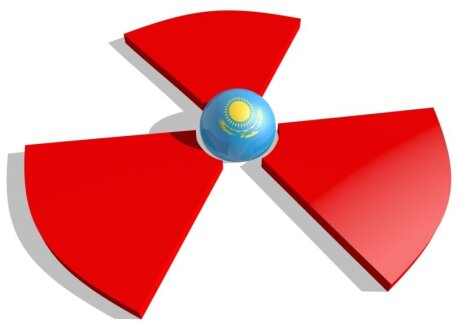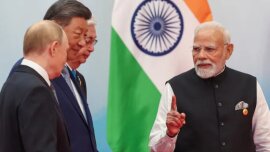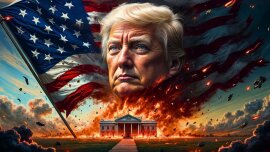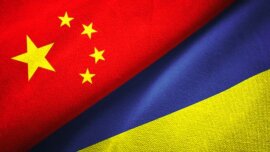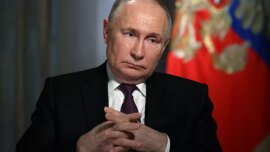Events in Kazakhstan are extremely difficult to understand. The whole tangle of players, problems and contradictions is like a multidimensional space with unstable, curvilinear and only partially deterministic coordinate planes. However, there are several main aspects. They are similar to coordinate planes in multidimensional spaces. The projections of events onto them are considered by numerous analysts. But projections in multidimensional space give little for understanding the overall picture, just like the projection of a cylinder onto a plane in the form of a circle or rectangle is terribly far from the three-dimensional image of an object.
However, there is no other way to study an object than by measuring its components in any coordinate system. Therefore, the efforts of analysts are reduced to the construction of a more or less correct coordinate system and a method of measurement in it. As a rule, considerations are expressed in the following coordinates:
- The geopolitical role of Kazakhstan in the US-Russia-China triangle and the possibility of its absorption by one or several players.
- Place of Kazakhstan in the world economy and economic interests of geopolitical players.
- Institutional matrix of Kazakhstan as a basis for predicting future events and opportunities for players (the role of pre-feudal zhuzes in politics and governance). The prospect of a split of the state into several state formations.
- Cultural and religious matrix of the Kazakh people and the prospect of Islamization.
In this article, I propose to look at another coordinate plane - Kazakhstan's place in the upcoming "green transition" of humanity .
Kazakhstan is rich in raw materials . A third of the country's GDP comes from oil, gas, gold, chromium, manganese, copper, molybdenum and much more. And also uranium. And although in monetary terms, the extraction and primary processing of uranium ore does not give very much - only 1.7 billion dollars, this industry is strategically important. Kazakhstan holds 42% of the world uranium market, and its possible transfer to the control of Russia (5% of the world market) will radically change Russia's place in the world production of energy resources of the future.
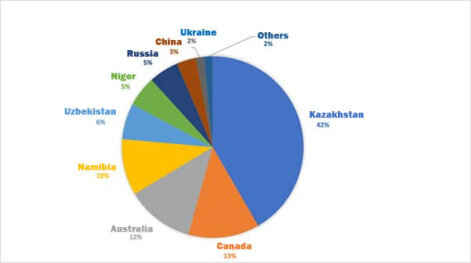
Share of countries in world uranium mining. Kazakhstan is the absolute leader with more than 40%
Kazakhstani uranium has several features. First of all, the deposits are concentrated in only three regions (see the map of the producing areas).
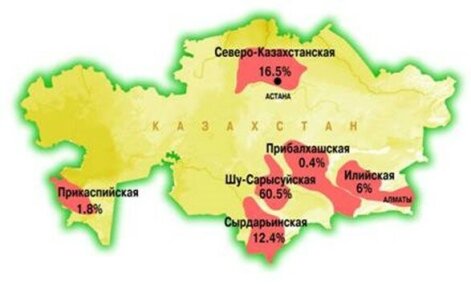
Uranium mining regions in Kazakhstan
Now let's compare this map with the map of the control of the country's territories by three zhuzes - historical clans that ruled the Kazakh people for centuries, despite the fact that the territories were part of the Russian Empire, the USSR, or independent Kazakhstan. The overlapping of these two maps shows that the overwhelming majority of the deposits are located in the territories controlled by the Senior Zhus, to which Nursultan Nazarbayev belongs. In fact, this clan controls the entire uranium industry.
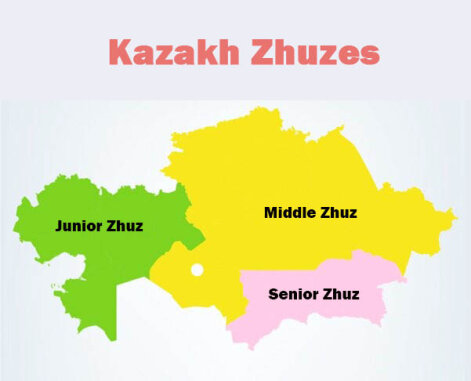
Kazakh Zhuzes
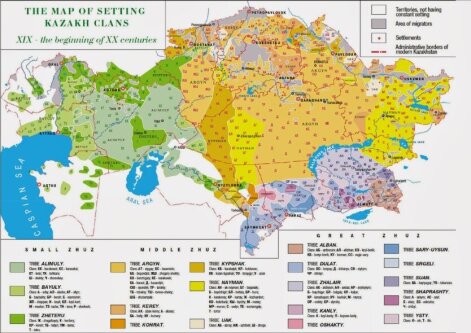
Kazakh Zhuzes
A feature of uranium deposits in Kazakhstan is the widespread possibility of mining by in-situ leaching of ore, which radically reduces the cost of production. Many deposits are located at shallow depths (400-500 m) and are covered with soft rocks.
The cost of producing uranium raw materials in Kazakhstan does not exceed 34 USD/kg, and at current world prices of 110 USD/kg, the industry has excellent prospects. Under the USSR, uranium concentrate was processed in Kyrgyzstan into uranium nitrous oxide and sent to Russia. For 30 years of independence, Nazarbayev was able to significantly modernize the industry and make it independent from Russia through the creation of joint ventures and foreign investments. In 2005, the Suzak District of South Kazakhstan Oblast (Muyunkum Desert), a new uranium processing plant was opened (with a capacity of 3200 t/y; with such a productivity, reserves will last for 400 years).
The United States showed interest in the extraction and processing of Kazakh uranium in the 2000s. This is not surprising, since the United States is the largest buyer of uranium in the world (27%). And although the United States has enough raw materials that they receive from Canada and Australia, they cannot ignore Kazakh uranium. Interesting facts and in many ways indicative, comw from Yulia Latynina. I will give her full quote:
“Or 2005 is a wonderful story. Former US President Bill Clinton arrives in Kazakhstan and takes with him a Canadian businessman named Frank Giustra. And what do you think? They talked with Nazarbayev, after which Nazarbayev sells a package of state uranium to Giustra, which makes his company - it is called Uranium One - the first uranium company, number one in the world. What does Clinton get? You will laugh, he receives $ 31 million in his fund account. And after that, Uranium One sells 20% of its stake to Rosatom. Once again, the deal is approved by a man named Clinton, this time Secretary of State Hillary Clinton. And the Clinton Foundation - Surprise-Surprise! - again receives various contributions from Uranium shareholders. For example, 5.6 million dollars from Jan Telfer, a shareholder."
Nice story, isn't it? (And they will teach us how to fight corruption?)
And what about China? What are their interests in this topic? China has no interests in Kazakhstani uranium. During the years of his rule, Nazarbayev never allowed his great neighbor to the uranium pie. Experiencing an acute shortage of nuclear fuel, China has made a bet on replacing uranium with thorium and is preparing to launch the world's first nuclear thorium reactor.
Why do I think that the uranium topic is extremely important when considering current events in Kazakhstan? Because humanity is on the verge of a "green transition", and the role of nuclear energy in it is a key.
By the end of 2021, energy experts agreed that the role and potential of renewable energy in the global energy mix was somewhat overestimated. And since nuclear energy does not produce a lot of hydrocarbon emissions, many countries are in favor of revising its role in the future energy balance. A number of EU countries (France, Romania, Czech Republic, Finland, Slovakia, Croatia, Slovenia, Bulgaria, Poland and Hungary) have come up with an initiative before the European Commission to include nuclear energy in the list of green industries (in the European taxonomy) by the end of 2021. It is very likely that this issue will be resolved positively. Moreover, during the transition period (until 2050), this sector will play a key role in greening the world economy. And control over raw materials is of great importance in the future alignment of forces on the world stage. Numerous foresights of the world economy show the most important trend of world events in the near future - the global battle for resources, namely land, water and energy. I am afraid that in Kazakhstan we are now witnessing an episode of a battle for the energy of the future.
The aggregate of Kazakhstani and Russian shares in the uranium market is close to 50%. If Russia wants to gain control over Kazakhstan's uranium as a "prize", it will sharply strengthen its position in the world balance of energy production. This development of events is dangerous for everyone.
In my opinion, the development of events in Kazakhstan may follow one of the following scenarios:
1. Restoration of the sovereignty of Kazakhstan. It cannot be fully restored; to one degree or another, the power in the state will depend on Russia. It is unlikely that Russia will refuse such a success - the possibility of including Kazakhstan in its orbit. In this case, it will inevitably put the uranium industry under its control. At the same time, a dictatorship of the most rude Asian kind, in fact, a despotism, will most likely be established in Kazakhstan. Thousands of prisoners will be sent to uranium mines as free labor, making the uranium business even more attractive.
2. Protracted civil war. One of the main demands of the recent protests was the granting of equal participation of the zhuzes in governing the country. All power under Nazarbayev belonged to the Senior Zhuz. The Juinor zhuz was especially unhappy with this state of affairs. The age-old contradictions between these medieval clans are insoluble. For many centuries, the zhuzes were unable to create their own states, or find peace among themselves. Add to this the fact that institutionally Kazakh clans are not even feudal formations, but pre-feudal proto-states. The transition from feudal communities to capitalism is painful, but possible. The leap from a pre-feudal society with common clan property to capitalism with full private property has not yet been seen in history.
The contradictions between the clans can become the basis for a protracted civil war. And since there are not two clans, but three, since in the event of a war, radical Islam will also appear on the scene, Russia will plunge not into a second Afghanistan, but to a second Syria. In this case, the fate of uranium mines is very problematic. Now most of them are on the territory of the Senior Zhuz and are controlled by the Nazarbayev family. If radical Islam comes from the south, this order can be easily destroyed. The consequences of establishing control over the mining and production of uranium oxide by the Islamists can be catastrophic. In this case, the collective West will be forced to intervene despite Russia's opposition.
3. The collapse of Kazakhstan. Possible as a result of agreements between the zhuzes and as a result of the civil war. In this scenario, Russia will bite off the Russian-speaking Northern Kazakhstan from the Middle Zhuz and begin to negotiate for Baikonur. The remaining territory will be divided between the zhuzes. Most of the uranium mines will go to the Senior Zhuz, that is, the Nazarbayev family. It is unlikely that Russia will be able to establish control over them.
Thus, Russia is satisfied with only the first scenario, the West - only the third, the Islamists - the second, China - like Russia, the first.
We will soon find out what scenario will take place in reality. There are too many variables to try to predict Asian processes. This is a view of the multidimensional reality of Kazakhstan from the plane of the "green transition". And there are many such coordinate planes in this story.
